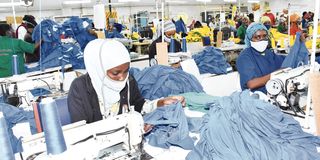Prime
Fresh hope as manufacturing sees robust growth in five years

Tanzania's manufacturing sector has demonstrated remarkable growth over the past five years, posting a 67 percent increase in export earnings despite still trailing behind non-traditional exports in terms of overall value. PHOTO | FILE
What you need to know:
- Tanzania's manufacturing sector has demonstrated remarkable growth over the past five years, posting a 67 percent increase in export earnings
Dar es Salaam. Tanzania's manufacturing sector has demonstrated remarkable growth over the past five years, posting a 67 percent increase in export earnings despite still trailing behind non-traditional exports in terms of overall value.
Bank of Tanzania (BoT) data from the period between June 2020 and June 2024 shows that the sector’s export earnings surged to $1.32 billion, up from $795 million in 2020.
This significant rise underscores the sector's potential as a future driver of general export growth.
According to the BoT, among the top-performing manufactured goods during this period, glassware exports stood out with a 101 percent increase, more than doubling their value to $73 million from $36 million.
Exports of glassware are expected to rise even more after President Samia Suluhu Hassan witnessed the official launch of a $300 million Sapphire Float Glass Factory in Mkuranga, Coast Region. It is among the largest glass factories in Africa.
In May, this year, glass bottle manufacturer Kioo Limited announced that it has received its much-needed boost when the International Finance Corporation (IFC) and Standard Bank of South Africa injected $60 million (about Sh156 billion) in capital into the factory.
Kioo Limited said at that time that the financing was meant to support the expansion of its manufacturing capacity to meet increasing domestic and regional demand for glass bottles and containers.
Under the partnership arrangement, IFC will provide a loan of up to $45 million while Standard Bank will provide up to $15 million to help Kioo grow its manufacturing capacity and increase its exports potential.
An analysis of the BoT’s data show that cosmetic goods also showed impressive growth, with export earnings rising by 89 percent to $37 million, up from $19.9 million, while edible oil exports climbed by 67.59 percent to $24.3 million, compared to $14.5 million five years earlier.
The export of plastic items grew by 54.5 percent, reaching $39.4 million from $25.5 million, while iron and steel exports, which remain the largest in value within this category, rose by 33 percent to $77.2 million from $58 million.
While cement products saw a modest increase in export value, growing slightly to $38.6 million from $38.3 million, experts suggest that the sector’s overall trajectory is promising.
A senior economist and director at the Centre for Chinese Studies at the University of Dar es Salaam, Prof Humphrey Moshi, said the five-year growth can also be attributed to the implementation of the National Development Vision 2025.
The vision recognises the leading role of the industrial sector in the process of transforming Tanzania’s economy from a weather and market-dependent agricultural economy to a self-sustainable semi-industrial one by 2025.
“Through this agenda, the country has been able to diversify, increase production and add value to primary products that were previously exported in their raw form,” he said.
However, Prof Moshi noted that value addition in some products, especially in the agricultural sector, remains low.
"These sectors (industry and agriculture) have a symbiotic relationship, where both sectors rely on each other for their growth and sustenance," he said.
Prof Moshi also mentioned that there is an opportunity for Tanzania to utilise key trade partners, such as China, to influence investments in the agricultural sector to sustain exports of manufactured goods, create local jobs, and retain technological advancements domestically.
Repoa executive director Donald Mmari said the growth in manufacturing is attributed to the improved investment environment in the country, which has led to reduced production costs.
“As a result, many industries have been able to produce and compete in the markets, the opportunity to grow the manufacturing sector is still very large, as Tanzania continues to implement strategies to make itself more competitive by producing high-quality products,” he said.
Dr Mmari, an economist with extensive experience in policy analysis, advised that the country must ensure that we enhance the quality of our products to meet international standards and increase exports.
On the other hand, non-traditional exports continue to dominate Tanzania's export earnings, totalling $6.37 billion by the end of June 2024, up from $4.57 billion in 2020.
Gold exports alone accounted for $3.12 billion, representing a 20.4 percent increase from $2.59 billion five years prior. Horticulture products also exhibited substantial growth, more than doubling their export value to $415.4 million from $202.6 million.
Another key factor in driving Tanzania external trade is the implementation of the blueprint for business environment regulatory reforms, aimed at improving regulatory procedures, avoid regulatory overlaps and promote transparency.





